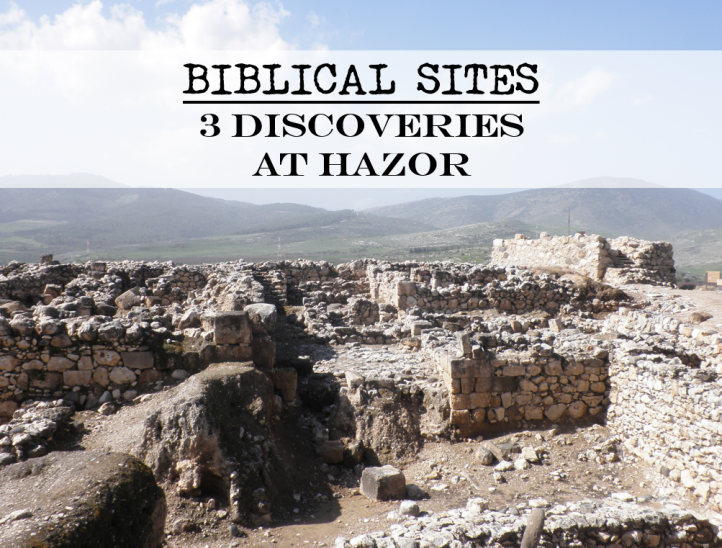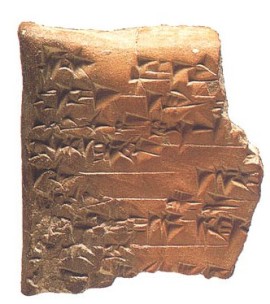
Hazor was the largest and most important site in Canaan at the time the Israelites entered the land. For comparison: Hazor was ten times the size of Jebus (Jerusalem) with a population of 15000-20000 people.1 It “was the head of all those kingdoms” in Canaan (Joshua 11:10) and is mentioned in both the Mari Texts (18th century B.C.) and the Armana Letters (14th century B.C.) in addition to the Bible.
Unlike the fortress of Ai, there has been no real debate regarding the location of the ancient city. Tel Hazor is the largest archaeological site in Israel at 200 acres in size. An initial investigation was undertaken by John Garstang in 1926, followed by major excavations led by Yigael Yadin (1955-58 and 1968) and Amnon Ben-Tor (1990-present). Over 30 years of digging has shed much light on the city of Hazor from the Old Testament. Here are three discoveries at Hazor which affirm details in the biblical text.
Jabin, King of Hazor

“Jabin, King of Hazor” is named in the conquest account in the book of Joshua (Joshua 11:1). We read of “Jabin king of Canaan, who reigned in Hazor” almost 150 years later in the time of the Judges (Judges 4:2). This has caused some to wonder if the two accounts are describing the same event, or if the Bible is simply mistaken in describing a king living for so long. Archaeology has helped to solve this apparent problem.
A tablet was discovered in the excavations at Hazor in 1992 addressed to Jabin, the King of Hazor, which dates to the 17th-18th centuries B.C.2 Another tablet from the Mari Texts (18th century B.C.) had previously been discovered naming “Yabni-Adad” (Jabin-Adad) as the king of Hazor.3 When one adds to these archaeological discoveries the biblical references above, it becomes clear that the name Jabin was applied to the kings of Hazor over a period of almost 400 years. It is likely that this was a dynastic title, not a given name; “Jabin, King of Hazor” similar to the use of “Pharaoh, king of Egypt” (Ex. 6:11). Yigal Yadin explains, “Scholars have suggested that the form of the name of the king of Hazor mentioned in the Bible—Yabin (Jabin being the Anglicized version)—is indeed short for the full theophoric formula. If this is true, then Yabin may have been a royal dynastic name of the kings of Hazor for quite a time.”4
Two Destruction Layers
The Bible describes two times the Israelites conquered and destroyed Hazor: once under Joshua during the Conquest and once under Barak and Deborah during the time of the Judges:
- 11:10-11 – And Joshua turned back at that time and captured Hazor and struck its king with the sword, for Hazor formerly was the head of all those kingdoms. And they struck with the sword all who were in it, devoting them to destruction; there was none left that breathed. And he burned Hazor with fire. (ESV)
- Judges 4:23-24 – So on that day God subdued Jabin the king of Canaan before the people of Israel. And the hand of the people of Israel pressed harder and harder against Jabin the king of Canaan, until they destroyed Jabin king of Canaan. (ESV) Archaeologist, Dr. Bryant Wood rightly points out that “The destruction of Jabin implies the destruction of his capital city Hazor.”5
Thus, we should expect to see evidence in the archaeological record of destruction at least twice: once in the 15th century BC (under Joshua) and again in the 13th century BC (under Barak and Deborah). This is precisely what excavations have revealed.
Both Yadin and Ben-Tor discovered evidence of destruction of the final Canaanite city by a huge conflagration in the 13th century B.C. (Late Bronze Age IIB/III).6 This would correspond to the destruction of the city by the Israelites under Barak and Deborah in the time of the Judges. Interestingly, both excavators also found evidence of an earlier destruction of the city in the 15th century B.C. (Late Bronze Age I) which would be attributed to Joshua. In fact, it appears that the Canaanite cultic centers were specifically targeted in this destruction, which would be in accordance with Moses’s instructions in Deut. 7:5.7 After analyzing both Yadin’s and Ben-Tor’s excavation reports, archaeologist Douglas Petrovich summarizes:
“Given Ben-Tor’s comparison of the fiery destruction of the Late-Bronze-I city to that of the Late-Bronze-IIB/III city, together with Yadin’s description of a violent fire and a total destruction characterizing the fate of the latter, the Hazor of Joshua’s day clearly was destroyed by a massive conflagration, as well. Evidence of this conflagration is visible in Area M on the northern slope of the tel, thanks to the excavations of 2000 and 2001. Various sections of the burnline and residual burned areas, which measure half of a meter in some places, have been preserved since the excavations in this part of Area M ceased in 2001. This burnline, visible throughout the excavated area, reveals the unmistakable signs of a great conflagration.8
The archaeological evidence of two destruction layers matches the biblical description of both Joshua and Barak/Deborah’s campaigns against the city and fits the biblical chronology of a 15th-century B.C. conquest of Canaan. Those who hold to a 13th-century conquest and believe the final Canaanite city was destroyed by Joshua are hard pressed to explain both the earlier destruction of Hazor as well as how Barak and Deborah would have destroyed a city, in the time of the Judges, that no longer existed. The most natural reading of both the biblical text and the archaeological evidence is that Joshua destroyed the city in the 15th century B.C. and Barak/Deborah destroyed it in the 13th century B.C.
The City Gates

In 1Kings 9:15 we read, “And this is the account of the forced labor that King Solomon drafted to build the house of the LORD and his own house and the Millo and the wall of Jerusalem and Hazor and Megiddo and Gezer…” (ESV).
One of the most striking features at Tel Hazor today is the six-chambered city gate. It dates to the 10th century B.C., leading the current excavators to conclude it “can most probably be attributed to King Solomon (1 Kings 9:15).”9 It seems that during the reign of Solomon only the western part of the upper tell was occupied. Later, during the rein of Ahab the city was expanded, before being destroyed in the 8th century B.C. by the Assyrian king, Tiglath Pileser III (2 Kings 15:29).
Many have noted that the city gate at Hazor is nearly identical to the six-chambered gates at Gezer and Megiddo. These gates were also initially dated to the time of Solomon, although some have recently questioned this dating of Megiddo’s gates. Many scholars have concluded that the best explanation is that they were all built by the same government.10
Summary
The Jabin Tablets, the two destruction layers and the city gate of Hazor are three significant discoveries at Hazor which affirm biblical details about the city.
Endnotes:
1 “Archaeologist Amnon Ben-Tor Explains Hazor on Site,” YouTube video, 14:58, “Galyn Wiemers,” July 10, 2012, https://www.youtube.com/watch?v=RBlyCPahw3s
2 “Excavation Report – Tel Hazor – 1992,” Hazor-Excavations.org. http://www.hazor-excavations.org/excavations-reports/tel-hazor-1992/ (Accessed April 16, 2019)
3 Kenneth A. Kitchen, On the Reliability of the Old Testament (Grand Rapids: Eerdmans, 2003), 175.
4 Yigael Yadin, Hazor: The Rediscovery of a Great Citadel of the Bible (New York: Random House, 1975), 250.
5 Bryant G. Wood, “The Biblical Date for the Exodus is 1446 BC: A Response to James Hoffmeier,” Associates for Biblical Research, March 30, 2009. http://www.biblearchaeology.org/post/2009/03/30/The-Biblical-Date-for-the-Exodus-is-1446-BC-A-Response-to-James-Hoffmeier.aspx (Accessed April 17, 2019).
6 Amnon Ben-Tor, “Who Destroyed Canaanite Hazor?” BAR 39:4 (July/August 2018), 28-30.
7 Bryant G. Wood, “Let The Evidence Speak.” Associates for Biblical Research. March 28, 2007. http://www.biblearchaeology.org/post/2007/03/28/Let-the-Evidence-Speak.aspx (Accessed April 17, 2019).
8 Douglas N. Petrovich, “The Dating of Hazor’s Destruction in Joshua 11 via Biblical, Archaeological, & Epigraphical Evidence.” Journal of the Evangelical Theological Society, 2008.
9 “The History of Hazor,” Hazor-Excavations.org. http://www.hazor-excavations.org/the-history-of-hazor/ (Accessed April 18, 2019).
10 “Hazor,” BiblePlaces.com. https://www.bibleplaces.com/hazor/ (Accessed April 18, 2019).
Cover Photo: Qasinka/Wikimedia Commons/Public Domain

[…] (11:11). Indeed, we do find archaeological evidence of destruction by fire at Jericho, Ai, and Hazor around 1400 BC, exactly as the Bible describes. In Joshua 6, we read a description of the fall of […]
[…] Biblical sites : Three discoveries at Hazor […]